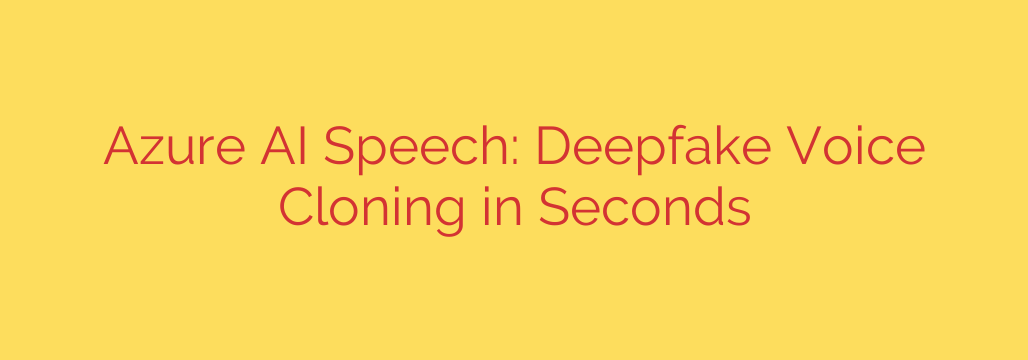
AI Voice Cloning Has Arrived: Understanding the Power and Peril of Synthetic Voices
Imagine receiving a frantic phone call from a family member who is in trouble and desperately needs money. Their voice is unmistakable—you recognize every inflection and tone. Your instinct is to help immediately. But what if it wasn’t them? This scenario is no longer science fiction; it’s the reality of modern AI voice cloning.
Recent advancements in artificial intelligence, particularly from major platforms like Microsoft’s Azure AI Speech, have made it possible to create a highly realistic, synthetic copy of a person’s voice from just a few seconds of audio. This technology holds incredible promise, but it also opens the door to a new generation of sophisticated scams and misinformation. Understanding both sides of this powerful tool is essential for navigating our increasingly digital world.
What is AI Voice Cloning Technology?
AI voice cloning, also known as synthetic voice generation, is the process of using artificial intelligence to analyze the unique characteristics of a person’s voice—their pitch, pace, and accent—and create a digital model. This model can then be used to generate new speech, saying anything you type in the original person’s voice.
Historically, creating a realistic digital voice required hours of professional-grade audio recorded in a studio. Today, the game has changed completely. New “personal voice” features can produce a high-fidelity voice clone from as little as 60 seconds of sample audio. The result is a natural-sounding voice that is often indistinguishable from the real person to the untrained ear.
The Double-Edged Sword: Innovation vs. Exploitation
The potential benefits of this technology are immense and genuinely life-changing for many.
Positive Use Cases:
- Accessibility: For individuals who have lost their ability to speak due to medical conditions like ALS or throat cancer, voice cloning offers a way to communicate using a voice that is truly their own.
- Personalization: Digital assistants, GPS navigation, and automated customer service can be customized with a familiar or preferred voice, creating a more personal and engaging user experience.
- Content Creation: Podcasters, audiobook narrators, and video creators can correct errors or generate new content without having to re-record entire sessions.
However, where there is light, there is also shadow. The same technology that offers hope and convenience can be easily weaponized by malicious actors. The primary risk is the rise of deepfake voice scams, which leverage cloned voices for fraudulent purposes.
Common Malicious Uses:
- Financial Fraud: Scammers can impersonate a loved one in distress (the “grandparent scam”), a CEO authorizing a wire transfer, or a bank representative to trick victims into sending money or revealing sensitive information.
- Disinformation: Imagine a fake audio clip of a political leader announcing a new policy or a corporate executive admitting to fraud. The potential to sow chaos and manipulate public opinion is significant.
- Harassment and Blackmail: Abusive individuals could use voice clones to create fake, incriminating audio of a person to damage their reputation or extort them.
A Call for Responsibility: Ethical AI and Safeguards
Recognizing these dangers, technology leaders are attempting to build ethical guardrails into their platforms. For example, access to the most powerful voice cloning features is often restricted. Companies may require users to go through an application process and agree to a strict code of conduct that explicitly prohibits deceptive or malicious use.
Furthermore, developers are working on technologies like digital watermarking, which embeds an inaudible signal into synthetic audio to help identify it as AI-generated. The core principle driving these efforts is “Responsible AI”—an approach that prioritizes safety, fairness, and transparency in the development and deployment of artificial intelligence. Users of these platforms are typically required to obtain explicit consent from the person whose voice they intend to clone.
How to Protect Yourself From Deepfake Voice Scams
While tech companies have a role to play, personal vigilance is your best defense against voice-based scams. Here are actionable steps you can take to protect yourself and your family.
Verify Through a Different Channel. If you receive a suspicious and urgent call requesting money or personal information, hang up immediately. Contact the person directly using a phone number you know is theirs or through a different communication method, like a text message or video call, to confirm the story.
Establish a “Safe Word.” This is a simple but highly effective tactic. Agree on a secret word or phrase with your close family members that you can use to verify each other’s identity during a phone call or text exchange if you suspect something is wrong.
Be Skeptical of Urgency and Secrecy. Scammers thrive on creating a sense of panic to prevent you from thinking clearly. Any request that demands immediate action and insists on secrecy should be treated as a major red flag. Take a moment to pause, breathe, and think before acting.
Secure Your Digital Footprint. Be mindful of the audio and video content you share publicly online. Social media posts, podcasts, and videos can all serve as training data for someone looking to clone your voice. Consider making your accounts private to limit access.
The era of AI-generated voices is here, and it’s not going away. This technology represents a monumental leap forward, offering tools that can empower and assist us in incredible ways. Yet, we must remain acutely aware of its potential for misuse. By promoting responsible development and practicing smart, skeptical digital habits, we can harness the power of synthetic voices while safeguarding ourselves from the perils.
Source: https://go.theregister.com/feed/www.theregister.com/2025/07/31/microsoft_updates_azure_ai_speech/








